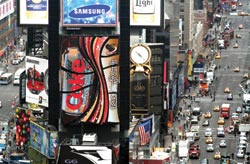As ad budgets are cut, what better way to broadcast a message than to install a large flat panel display where it will reach a captive audience? These advertisements are popping up in railway stations, airports and shopping malls – anyplace where busy professionals will get the message at a single glance. The sign industry remains strong, possibly as a result of these tough economic times – with analysts predicting growth of more than 40 percent in 2009. The massively lit displays are signs of the times in more ways than one. These electricity hogs are joining the trend toward green – albeit, in this case, light green.
Historically, outdoor electronic signs have moved from incandescent to neon to fluorescent – and now to LEDs. Pamela Thompson, vice president of marketing at Folsom, Calif.-based Sugarman Consulting, said that the biggest savings in electricity in the signage industry occurred “when we moved from incandescent to LEDs.” One benefit of the new high-brightness LEDs, she pointed out, is that you need fewer diodes and less power to achieve the same brightness levels compared with just a few years ago.
The move to LEDs
In New York City, it’s not just the New Year’s Eve ball that’s lit by energy-saving LEDs. “More than a million people pass through Times Square each day, and it’s important for advertisers to know their branding efforts, utilizing spectacular LED displays, are stopping people in their tracks and making them take notice,” commented Randy Antes, director of digital projects in New York City for South Dakota-based Daktronics. The company has designed and manufactured many of the large displays in Times Square. He’s found LED displays to be more energy-efficient than the old incandescent bulbs, once the standard lighting element in Times Square displays, as well as more dynamic due to brightness and color clarity.

The 65-ft-high Coca-Cola display in Times Square is hard to miss with more than 2 million LEDs. Photo courtesy of Daktronics.
The famous Coca-Cola sign, a Times Square landmark since 1920, is a good example. Measuring 44 ft wide by 65 ft tall, it was converted to LEDs in 2004. According to Antes, what appears to be a sign is really a sophisticated video screen run by two control systems that include four processors and six servers, which can store up to 120 hours of content. Data and graphics are sent over a T1 line at 60 fps. The display has 2,646,336 LEDs in 4000 modules of various sizes.
The transition to LEDs has not been without its challenges, however. As with other LED applications, power management and ventilation/cooling techniques have been employed to dissipate the heat. One of the big green changes here is controlling airflow through the sign rather than relying on massive air conditioning units.
Lighting up the night
Light pollution from electronic signs has negative health effects on people and wildlife (See articles in this issue), and many towns and states have ordinances regulating the amount of light that can be displayed at night. While Antes said “the rule of thumb in Times Square is to produce spectaculars on an awe-inspiring scale,” he indicated that, in some communities, sign and billboard companies do have to contend with restrictions as to light intensity and content motion on signs. The beauty of LED technology is the unlimited flexibility over visual content that is displayed and the ability to change it instantly. Content is fully controlled by the computer that runs the display. “You can easily ramp up or tone down the intensity, color and motion of the content, Antes said. “It’s all configured on a case-by-case basis and can be designed with consideration of respective community standards.”
Going solar?
One would think that a giant billboard would be a great spot for a solar collector – and in theory, it is. Regular billboards that don’t have electronic displays can be power generators, as demonstrated in San Francisco by the solar billboard sponsored by Pacific Gas & Electric, which displayed the message, “This is not a billboard, it’s a power plant.” The 20 solar panels installed on the billboard provided 3.4 kW of power in full sun, ran the LED lights above the display and fed unused power back to the grid. Times Square now has a solar- and wind-powered sign, but again, it’s not an electronic sign. But providing solar power to huge digital signage is not yet practical for most applications. According to Pamela Thompson of Sugarman Consulting, to fully power a 14- by 48-ft digital billboard, you’d need almost an acre of solar panels. Sugarman Consulting has done some projects with solar, but, as Thompson pointed out, unless the advertiser has very deep pockets and a whole lot of vacant land (for the solar collectors), solar just isn’t a viable option for large, power-hungry digital signage.
Thompson adds, “We are developing secondary solar power systems that augment the primary power source. Keeping the LED display cool is critical, often requiring a forced-air ventilation system or, in some cases, air conditioning. Using just a few solar panels mounted on the back of the sign, we can power a supplementary ventilation system that kicks in during the hottest and brightest part of the day.”